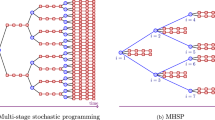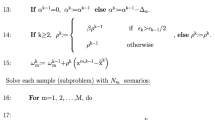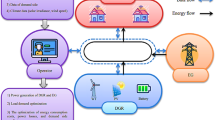Abstract
Utilization of Distributed Generation (DG) resources has increased dramatically in power systems due to economic and environmental benefits. Risk-based planning methods could manage the operational and economic risks at acceptable levels. In this paper a new probabilistic multi-objective risk-based DG planning method is proposed. In the proposed method, operation and investment costs minimization, reliability improvement, losses minimization, and operational risks minimization are considered. Uncertainties of wind generation and demand are modeled by using scenario tree and two stage method. The multi-objective problem is solved by using a combination of lexicographic optimization technique and hybrid augmented weighted ε-constraint approach. In addition, fuzzy satisfying criterion is used for decision making among Pareto solutions. Analyzing the numerical results validated that the proposed method has an appropriate and accurate performance in achieving the set of Pareto solutions. By analyzing the Pareto solutions, it is proved that by more investment on DG allocation, reduction of loss and operation risk could be appropriately achieved. Comprehensive risk analysis of wind energy generation and the curtailment of wind power are conducted under different cases. It is concluded that when the wind power injection increases the negative effects on the power system increase. Moreover, in case of considering wind power curtailment, the risk factor significantly reduced.









Similar content being viewed by others
References
Jannesar MR, Sedighi A, Savaghebi M, Guerrero JM (2018) Optimal placement, sizing, and daily charge/discharge of battery energy storage in low voltage distribution network with high photovoltaic penetration. Appl Energy 226:957–966. https://doi.org/10.1016/j.apenergy.2018.06.036
Abdmouleh Z, Gastli A, Ben-Brahim L, Haouari M, Al-Emadi NA (2017) Review of optimization techniques applied for the integration of distributed generation from renewable energy sources. Renew Energy 113:266–280. https://doi.org/10.1016/j.renene.2017.05.087
Nahman JM, Perić DM (2020) Radial distribution network planning under uncertainty by applying different reliability cost models. Int J Electr Power Energy Syst. https://doi.org/10.1016/j.ijepes.2019.105655
Qiao X, Luo Y, Xiao J, Li Y, Jiang L, Shao X, Xu J, Tan Y, Cao Y (2020) Optimal scheduling of distribution network incorporating topology reconfiguration, BES and load response: a MILP model. CSEE J Power Energy Syst. https://doi.org/10.17775/CSEEJPES.2019.02300
Viral R, Khatod DK (2012) Optimal planning of distributed generation systems in distribution system: a review. Renew Sustain Energy 16:5146–5165. https://doi.org/10.1016/j.rser.2012.05.020
Li H, Ren Z, Fan M, Li W, Xu Y, Jiang Y, Xia W (2022) A review of scenario analysis methods in planning and operation of modern power systems: methodologies, applications, and challenges. Electric Power Syst Res 205:107722
Ehsan A, Yang Q (2019) State-of-the-art techniques for modeling of uncertainties in active distribution network planning: a review. Appl Energy 239:11509–11523. https://doi.org/10.1016/j.apenergy.2019.01.211
Ugranl F (2020) Probabilistic distribution planning: Including the interactions between chance constraints and renewable energy. Sustain Energy, Grids Netw. https://doi.org/10.1016/j.segan.2020.100372
Ahmed A, Nadeem MF, Sajjad IA, Bo R, Khan IA, Raza A (2020) Probabilistic generation model for optimal allocation of wind DG in distribution systems with time varying load models. Sustain Energy, Grids and Netw. https://doi.org/10.1016/j.segan.2020.100358
Pirouzi S, Zaghian M, Aghaei J, Chabok H, Abbasi M, Norouzi M, Catalão JP (2022) Hybrid planning of distributed generation and distribution automation to improve reliability and operation indices. Int J Electr Power Energy Syst 135:107540
Faraji E, Abbasi AR, Nejatian S, Zadehbagheri M, Parvin H (2021) Probabilistic planning of the active and reactive power sources constrained to securable-reliable operation in reconfigurable smart distribution networks. Electric Power Syst Res 199:107457
Wang W, Huang Y, Yang M, Chen C, Zhang Y, Xu X (2022) Renewable energy sources planning considering approximate dynamic network reconfiguration and nonlinear correlations of uncertainties in distribution network. Int J Electr Power Energy Syst 139:107791
Xu T, Ren Y, Guo L, Wang X, Liang L, Wu Y (2021) Multi-objective robust optimization of active distribution networks considering uncertainties of photovoltaic. Int J Electr Power Energy Syst 133:107197
Ehsan A, Yang Q (2018) Optimal integration and planning of renewable distributed generation in the power distribution network. A review of analytical techniques. Appl Energy 210:44–59. https://doi.org/10.1016/j.apenergy.2017.10.106
Reddy PD, Reddy VV, Manohar TG (2017) Whale optimization algorithm for optimal sizing of renewable resources for loss reduction in distribution systems. Renew Wind, Water Solar 45:454. https://doi.org/10.1186/s40807-017-0040-1
Ahmed A, Khan MFN, Khan I, Alquhayz H, Khan MA, Kiani AT (2021) A novel framework to determine the impact of time varying load models on wind DG planning. IEEE Access 9:11342–11357
Suresh MCV, Edward JB (2020) A hybrid algorithm based optimal placement of DG units for loss reduction in the distribution system. Appl Soft Comput 91:106191
Veera Reddy VC (2018) Ant Lion optimization algorithm for optimal sizing of renewable energy resources for loss reduction in distribution systems. J Electr Syst Inform Technol 5(3):663–680
Haidar AM, Fakhar A, Helwig A (2020) Sustainable energy planning for cost minimization of autonomous hybrid microgrid using combined multi-objective optimization algorithm. Sustain Cities Soc 62:102391
Kumar S, Mandal KK, Chakraborty N (2019) Optimal DG placement by multi-objective opposition based chaotic differential evolution for techno-economic analysis. Appl Soft Comput 78:70–83
Prakash DB, Lakshminarayana C (2018) Multiple DG placements in radial distribution system for multi objectives using whale optimization algorithm. Alex Eng J 57(4):2797–2806
Pandey RS, Awasthi SR (2020) A multi-objective hybrid algorithm for optimal planning of distributed generation. Arab J Sci Eng 45(4):3035–3054
Ganguly S (2020) Multi-objective distributed generation penetration planning with load model using particle swarm optimization. Decision Making: Appl Manage Eng 3(1):30–42
Nowdeh SA, Davoudkhani IF, Moghaddam MH, Najmi ES, Abdelaziz AY, Ahmadi A, Gandoman FH (2019) Fuzzy multi-objective placement of renewable energy sources in distribution system with objective of loss reduction and reliability improvement using a novel hybrid method. Appl Soft Comput 77:761–779
Hadidian-Moghaddam MJ, Arabi-Nowdeh S, Bigdeli M, Azizian D (2018) A multi-objective optimal sizing and siting of distributed generation using ant lion optimization technique. Ain Shams Eng J 9(4):2101–2109
Jafari A, Khalili T, Ganjehlou HG, Bidram A (2020) Optimal integration of renewable energy sources, diesel generators, and demand response program from pollution, financial, and reliability viewpoints: A multi-objective approach. J Clean Prod 247:119100
Zhao Q, Wang S, Wang K, Huang B (2019) Multi-objective optimal allocation of distributed generations under uncertainty based on D-S evidence theory and affine arithmetic. Int J Electr Power Energy Syst 112:70–82. https://doi.org/10.1016/j.ijepes.2019.04.044
Kianmehr E, Nikkhah S, Rabiee A (2019) Multi-objective stochastic model for joint optimal allocation of DG units and network reconfiguration from DG owner’s and DisCo’s perspectives. Renew Energy 132:471–485. https://doi.org/10.1016/j.renene.2018.08.032
Mukhopadhyay B, Das D (2020) Multi-objective dynamic and static reconfiguration with optimized allocation of PV-DG and battery energy storage system. Renew Sustain Energy Rev. https://doi.org/10.1016/j.rser.2020.109777
Zhang SH, Cheng H, Li K, Tai N, Wang D, Li F (2018) Multi-objective distributed generation planning in distribution network considering correlations among uncertainties. Appl Energy 226:743–755. https://doi.org/10.1016/j.apenergy.2018.06.049
Ahmadi B, Ceylan O, Ozdemir A, Fotuhi-Firuzabad M (2022) A multi-objective framework for distributed energy resources planning and storage management. Appl Energy 314:118887
Davoodi A, Abbasi AR, Nejatian S (2022) Multi-objective techno-economic generation expansion planning to increase the penetration of distributed generation resources based on demand response algorithms. Int J Electr Power Energy Syst 138:107923
Akbar MI, Kazmi SAA, Alrumayh O, Khan ZA, Altamimi A, Malik MM (2022) A novel hybrid optimization-based algorithm for the single and multi-objective achievement with optimal DG allocations in distribution networks. IEEE Access 10:25669–25687
Xiao F, McCalley JD (2009) Power system risk assessment and control in a multi-objective framework. IEEE Trans Power Syst 24:78–85. https://doi.org/10.1109/TPWRS.2008.2004823
Gitizadeh M, Kaji M, Aghaei J (2013) Risk based multiobjective generation expansion planning considering renewable energy sources. Energy 50:74–82. https://doi.org/10.1016/j.energy.2012.11.040
Esmaeeli M, Kazemi A, Shayanfar H, Chicco G, Siano P (2017) Risk-based planning of the distribution network structure considering uncertainties in demand and cost of energy. Energy 119:578–587. https://doi.org/10.1016/j.energy.2016.11.021
Jin T, Tian Z (2010) Uncertainty analysis for wind energy production with dynamic power curves. In: 2010 IEEE 11th international conference on probabilistic methods applied to power systems, pp. 745–750
Çois Bouffard F, Galiana FD (2008) Stochastic security for operations planning with significant wind power generation. IEEE Trans Power Syst 23:306–316. https://doi.org/10.1109/TPWRS.2008.919318
Zakariazadeh A, Jadid S, Siano P (2014) Economic-environmental energy and reserve scheduling of smart distribution systems: A multi-objective mathematical programming approach. Energy Convers Manag 78:151–164. https://doi.org/10.1016/j.enconman.2013.10.051
Ma W, Xue X, Liu G, Zhou R (2018) Techno-economic evaluation of a community-based hybrid renewable energy system considering site-specific nature. Energy Convers Manage 171:1737–1748
Wang P, Billinton R (2000) Optimum load-shedding technique to reduce the total customer interruption cost in a distribution system. IEE Proc-Gener, Trans Distrib 147(1):51–56
Bahramara S, Moghaddam MP, Haghifam MR (2016) A bi-level optimization model for operation of distribution networks with micro-grids. Int J Electr Power Energy Syst 82:169–178
Ehsan A, Yang Q (2018) Optimal integration and planning of renewable distributed generation in the power distribution networks: a review of analytical techniques. Appl Energy 210:44–59
Ogryczak W, Sliwinski T (2010) Efficient portfolio optimization with conditional value at risk. IEEE Int Multi-conference Comput Sci Inform Technol. https://doi.org/10.1109/IMCSIT.2010.5679952
Deng W, Ding H, Zhang B, Lin XN, Bie P, Wu J (2016) Multi-period probabilistic-scenario risk assessment of power system in wind power uncertain environment. IET Gener Trans Distribution 10:359–365. https://doi.org/10.1049/iet-gtd.2015.0416
Zou K, Agalgaonkar AP, Muttaqi KM, Perera S (2011) Distribution system planning with incorporating DG reactive capability and system uncertainties. IEEE Trans Sustain Energy 3(1):112–123
Aghaei J, Akbari MA, Roosta A, Gitizadeh M, Niknam T (2012) Integrated renewable conventional generation expansion planning using multiobjective framework. IET Gener Trans Distribution 6:773–784. https://doi.org/10.1049/iet-gtd.2011.0816
Aghaei J, Amjady N, Shayanfar HA (2011) Multi-objective electricity market clearing considering dynamic security by lexicographic optimization and augmented epsilon constraint method. Soft Comput 11:3846–3858. https://doi.org/10.1016/j.asoc.2011.02.022
Ghaljehei M, Soltani Z, Lin J, Gharehpetian GB, Golkar MA (2019) Stochastic multi-objective optimal energy and reactive power dispatch considering cost, loading margin and coordinated reactive power reserve management. Electr Power Syst Res 166:163–177. https://doi.org/10.1016/j.epsr.2018.10.009
Baran ME, Wu FF (1989) Network reconfiguration in distribution systems for loss reduction and load balancing. IEEE Trans Power Delivery 4:1401–1407. https://doi.org/10.1109/61.25627
Author information
Authors and Affiliations
Corresponding author
Additional information
Publisher's Note
Springer Nature remains neutral with regard to jurisdictional claims in published maps and institutional affiliations.
Rights and permissions
Springer Nature or its licensor (e.g. a society or other partner) holds exclusive rights to this article under a publishing agreement with the author(s) or other rightsholder(s); author self-archiving of the accepted manuscript version of this article is solely governed by the terms of such publishing agreement and applicable law.
About this article
Cite this article
Ostvar, F., Barati, H. & Mortazavi, S.S. Probabilistic Risk-Based Planning of Distributed Generation Units Using Multi Objective Hybrid Augmented Weighted ε-Constraint Approach. J. Electr. Eng. Technol. 18, 3517–3531 (2023). https://doi.org/10.1007/s42835-023-01451-w
Received:
Revised:
Accepted:
Published:
Issue Date:
DOI: https://doi.org/10.1007/s42835-023-01451-w




